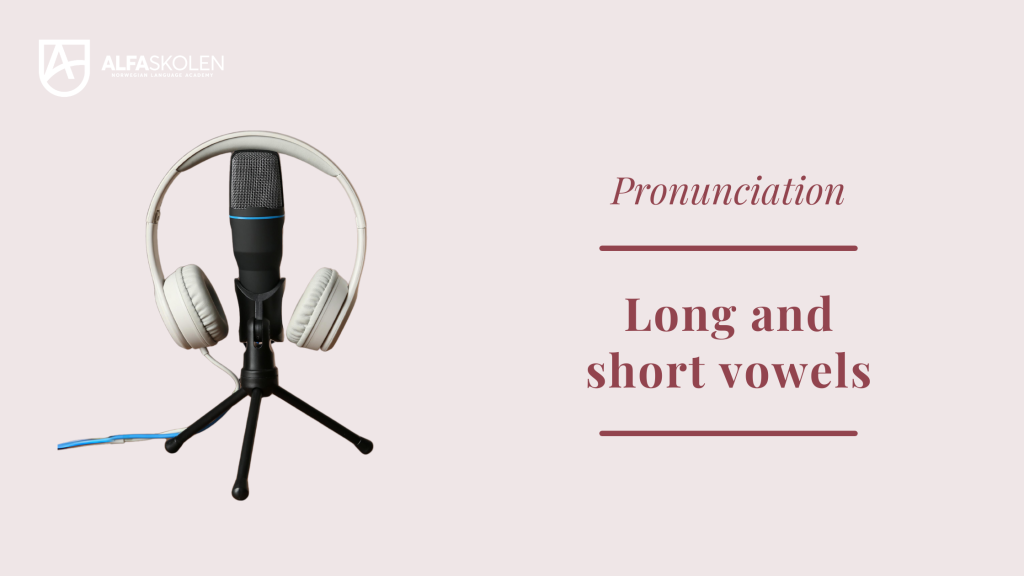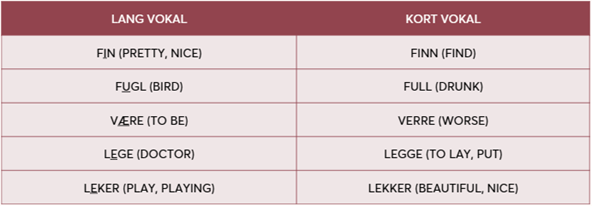Long and Short Vowels in Norwegian

In Norwegian, vowels come in two variants: short and long. The difference between them is important because it can change the meaning of a word. It’s one thing when written; most people can see the difference between pen (pretty) and penn (pen). However, pronunciation also plays a crucial role in understanding which word you mean. Therefore, it’s necessary to grasp the rules for pronouncing short and long vowels so that you can communicate your thoughts clearly and avoid misunderstandings.
This distinction is also crucial when preparing for the Norskprøve (Norwegian language proficiency test), especially the oral and listening part of the exam. Let’s take a closer look at the rules and patterns for pronouncing short and long vowels in Norwegian. To make it easier for you, we have marked long vowels with an underscore.
Norwegian Vowels
Let’s begin by taking a closer look at the Norwegian vowels. We have 9 of them, and they can be a bit different from vowels in other languages. For example, the letter i is pronounced in a different way in Norwegian than in English. Even though the word Island looks like the English word Iceland, it doesn’t sound exactly the same. That’s why it’s important to start by getting familiar with how vowels are pronounced in Norwegian. At Alfaskolen Norwegian courses, we always start with the alphabet because it is so crucial for building a strong foundation in the language. This will help you understand and be better understood when speaking Norwegian.
The Norwegian vowels are:

All these vowels have both a short and a long version. In the word pair pen and penn, we encounter two different e‘s. In pen, the e is long, and in penn, it’s short. It might seem like a very small difference, but this difference actually changes the meaning of the words. To understand this better, you can listen to the audio file and try to repeat it yourself. Listening and imitating is a great way to improve pronunciation when learning Norwegian:

Single and Double Consonant
The main rule for pronouncing Norwegian vowels is easy to remember: we say the vowel is long when it is followed by a single consonant and short when followed by a double consonant. This rule also applies to the word pair pen and penn. In the word pen, where there’s only one consonant after e, the e is long. But in penn, where there is a double n after e, the e is short.
Let’s explore more examples to see how this rule applies in other words:

With the main rule in mind, can you try pronouncing the words with the correct vowel length? Remembering the rule that the vowel is long when followed by a single consonant and short when followed by a double consonant will be very helpful. This principle applies to many Norwegian words, including the examples above. Start by reading the words aloud, then listen to the audio file. Repeat several times and compare the different vowel lengths. This is an important part of mastering the Norwegian language.
Whether you’re practicing alone or attending Alfaskolen’s conversational courses, a course with extra emphasis on pronunciation, with a bit of patience and practice, you’ll quickly get the hang of it!
Pronouns and Other Short Words
As in most cases, there are exceptions when it comes to short and long vowels. It’s important to be aware of these exceptions to gain a complete understanding of pronunciation principles in Norwegian. An interesting example of this is pronouns. Most pronouns are spelled with a single consonant, but the vowel is pronounced as short. When learning Norwegian, paying attention to these nuances will enhance your language skills and contribute to more accurate pronunciation.
To better grasp this, we recommend listening carefully to the audio file and examining the examples below:

Why are these words pronounced with a short vowel? This phenomenon can be explained by looking at one-syllable words, meaning words with only a single vowel, which also are followed by a single consonant. In many cases, the vowel is pronounced as short in such words. This applies to many pronouns, like jeg (I), han (he), and hun (she), where the vowel is followed by a single consonant.
Another interesting example is the words skal (shall/will) and vil (will). Even though the main rule might suggest that the vowels in skal and vil should be pronounced as long, it’s actually the opposite. These vowels are pronounced as short.
However, the pronouns vi (we) and du (you) are pronounced with a long vowel. This is because they are one-syllable words ending with a vowel and not followed by any consonants. In such cases, we often get a long vowel. This principle applies not only to pronouns but also to other one-syllable words sharing the same characteristic. For example, words like blå (blue), ku (cow), and be (ask, pray) are pronounced with a long vowel because they are also one-syllable words ending with a vowel without any consonants afterward.
Listen to the audio file and practice pronunciation along with us:
Due to these variations, our students already begin learning these pronunciation nuances right from the beginning in our beginner course.
Double M
We have a rule in Norwegian that says we can never write double m at the end of a word. Thus, we get words like hjem (home), tom (empty), and svøm (swim), all spelled with a single m. Listen to the audio file. Do you hear a short or long vowel?

If you heard a short vowel, you heard absolutely right. To understand this, we need to look at these words in other forms. These words are spelled with a single m, but this changes when we add another letter, usually e. Then the word is spelled with a double m; hjemme (home), tomme (empty), svømme (swim). Although there is variation in vowel length between words with a single and double consonant, it’s worth noting that the vowel is always pronounced the same way in words ending with m – short. Thus, we have a rule stating that the vowel in words ending with m, regardless of whether it’s single or double, is pronounced as short.

Compare the audio files. Do you hear a vowel difference between the vowels in hjem, tom, svøm and hjemme, tomme, svømme? No? Good, because there is no difference!
Double consonants in compound words
You may have heard of compound words, which are words formed by combining multiple individual words. Compound words are a common phenomenon in Norwegian grammar , and these words can belong to different word classes, such as nouns, adjectives, adverbs, or verbs. Sometimes, we get compound words where the first word ends with the same letter that the next word begins with. An example of this is sollys (sunlight). When it comes to pronouncing the word sollys, we still follow the main rule of a long vowel before a single consonant, even though we have a double l. In this case, we imagine that the first l belongs to the word sol, and the second l belongs to the word lys. Thus, we have no vowel change in such compound nouns. Here is a table with an overview of other examples:

Study tips
It is crucial to remember that in Norwegian, there will always be exceptions to the rules. One of the challenges is that there isn’t always a simple explanation for why certain words are pronounced in a specific way. For example, why fint has a long vowel while godt is pronounced with a short vowel may seem unclear. This underscores the importance of exposing yourself to the language, listening carefully to natural conversation, and regularly repeating words and phrases. An effective strategy is to write down both how the words are spelled and how they are pronounced. This helps you become more aware of the differences and makes it easier to remember the correct pronunciation. Using an underscore to mark a long vowel, as in fint, can be helpful, but you can also develop your own system to highlight these nuances.
Here are some more tips for mastering Norwegian pronunciation:
- Listen as much as possible: Practice your listening comprehension by immersing yourself in various Norwegian sources, such as podcasts, music, or TV programs. This exposure will familiarize you with diverse dialects and pronunciation styles, enhancing your language skills and preparing you for the Norskprøve.
- Conversation practice: Engage in oral Norwegian as much as possible, whether through language exchange with native speakers or structured conversations in a Norwegian language course. Applying what you’ve learned in practical situations will strengthen your pronunciation skills, a crucial aspect for those aiming to succeed in speaking fluent Norwegian.
- Focus on sounds: Identify specific sounds or combinations that may be challenging for you. Practice these deliberately to improve your pronunciation. This focused approach is beneficial for learners at different proficiency levels, from beginners to advanced students.
- Language community: Becoming part of a language community, whether online or at Alfaskolen Norwegian courses in Oslo, opens doors to shared experiences, constructive feedback, and learning from fellow language enthusiasts. By joining our free, social language cafés, you can practice speaking and pronunciation in a relaxed and supportive environment. Engaging in these casual settings not only develops motivation and support but also enriches your cultural understanding, making it an invaluable supplement to your Norwegian language studies.
Remember that patience and regular practice are the keys to developing clear and understandable pronunciation in a new language. Practice makes perfect!
Tags:


